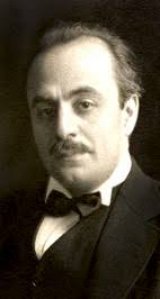Analysis of On Religion
Kahlil Gibran 1883 (Bsharri, Mount Lebanon Mutasarrifate) – 1931 ( New York City)
And an old priest said, Speak to us of Religion.
And he said:
Have I spoken this day of aught else?
Is not religion all deeds and all reflection,
And that which is neither deed nor reflection, but a wonder and a surprise ever springing in the soul, even while the hand hew the stone or tend the loom?
Who can separate his faith from his actions, or his belief from his occupations?
Who can spread his hours before him, saying, “This for God and this for myself’ This for my soul, and this other for my body?”
All your hours are wings that beat through space from self to self.
He who wears his morality but as his best garment were better naked.
The wind and the sun will tear no holes in his skin.
And he who defines his conduct by ethics imprisons his song-bird in a cage.
The freest song comes not through bars and wires.
And he to whom worshipping is a window, to open but also to shut, has not yet visited the house of his soul whose windows are from dawn to dawn.
Your daily life is your temple and your religion.
Whenever you enter into it take with you your all.
Take the plough and the forge and the mallet and the lute,
The things you have fashioned in necessity or for delight.
For in revery you cannot rise above your achievements nor fall lower than your failures.
And take with you all men:
For in adoration you cannot fly higher than their hopes nor humble yourself lower than their despair.
And if you would know God be not therefore a solver of riddles.
Rather look about you and you shall see Him playing with your children.
And look into space; you shall see Him walking in the cloud, outstretching His arms in the lightning and descending in rain.
You shall see Him smiling in flowers, then rising and waving His hands in trees.
| Scheme | AXXAXXXX XXXBX AXXX BXX XAXX |
|---|---|
| Poetic Form | |
| Metre | 011111111010 011 111011111 110101101010 01111011010101000011010001101011011101 1110111110110111010 111110011101110111111101101110 11101111111111 1111010011111001010 010011111011 01101101110010111001 01011111010 01111001010110110111111000111111011111 1101111001010 01011001111111 1010010010001 011110001001101 101110101101011101110 011111 1001011011011111001101101 011111111010110 10101101111101110 010111111100011110010001001 1111100101100101101 |
| Characters | 1,848 |
| Words | 332 |
| Sentences | 20 |
| Stanzas | 5 |
| Stanza Lengths | 8, 5, 4, 3, 4 |
| Lines Amount | 24 |
| Letters per line (avg) | 57 |
| Words per line (avg) | 14 |
| Letters per stanza (avg) | 276 |
| Words per stanza (avg) | 66 |
Font size:
Citation
Use the citation below to add this poem analysis to your bibliography:
Style:MLAChicagoAPA
"On Religion" Poetry.com. STANDS4 LLC, 2024. Web. 18 Apr. 2024. <https://www.poetry.com/poem-analysis/53997/on-religion>.


Discuss this Kahlil Gibran poem analysis with the community:
Report Comment
We're doing our best to make sure our content is useful, accurate and safe.
If by any chance you spot an inappropriate comment while navigating through our website please use this form to let us know, and we'll take care of it shortly.
Attachment
You need to be logged in to favorite.
Log In